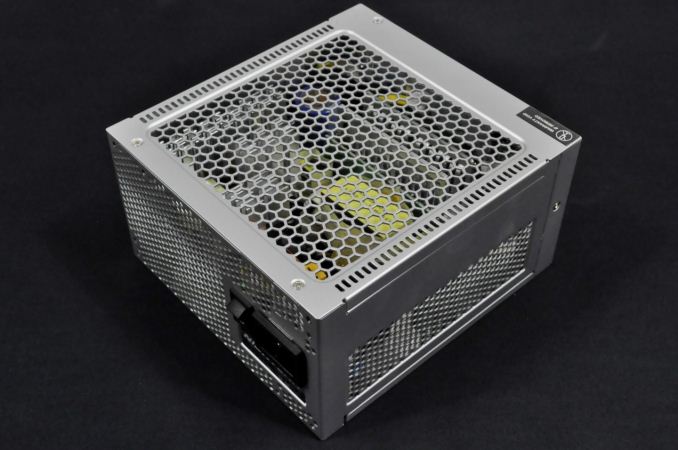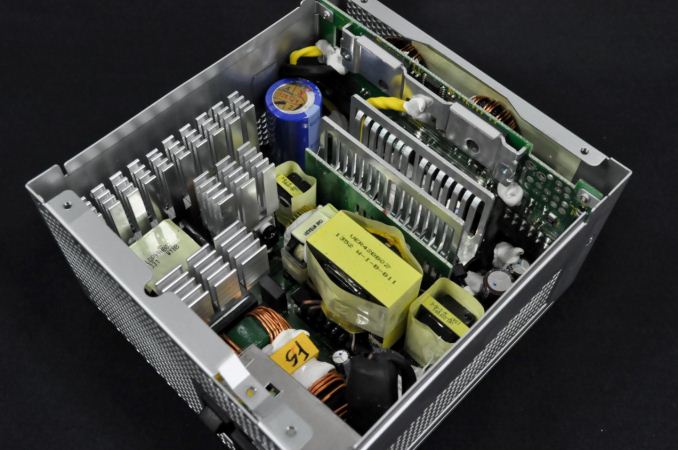SilverStone NightJar NJ520 Power Supply Review
by E. Fylladitakis on July 8, 2014 6:00 AM EST- Posted in
- Cases/Cooling/PSUs
- Seasonic
- PSUs
- Fanless
- SilverStone
External Appearance
In terms of size, the Nightjar NJ520 appears just like any other modular ATX PSU. Its silver chassis is 160mm deep, making it suitable for all ATX compliant cases. It is however noticeable that the PSU lacks a fan. The sides of the Nightjar NJ520 are perforated and, as the warning label indicates, the top side of the chassis has to be facing upwards when it is installed in a case, as the cooling scheme relies on convection via passive airflow. This will not be a problem for most modern tower cases, as they have a PSU compartment at or near their bottom; however, it will most certainly be an issue with tower cases that have the PSU compartment above the motherboard tray, or with most desktop/HTPC cases.
The front side of the chassis has even more openings for passive airflow, as well as the modular cable connectors. The connectors are black and there is a legend printed on the chassis, although they are keyed and you cannot install a cable into the wrong connector. The rear side is similar to that of any other ATX PSU, with an AC cable plug, a small switch and a metallic sticker with the series name beneath it.
Internal Design
After looking inside the Nightjar NJ520, we quickly identified that it is a Seasonic design, the one Seasonic is using for their own Platinum 520W Fanless model. There is a very strong filtering stage, partially shielded, consisting of six Y capacitors, three X capacitors and three filtering inductors. There is also a relay, which cuts off the AC supply to the unit entirely once it is turned off, to minimize losses while the system is powered off.
Despite the low output of the unit, there are two parallel rectifying bridges mounted on their own heatsink. The active APFC components, two transistors and a diode, are on the large heatsink near the edge of the PCB. The primary inversion stage consists of four switching transistors, forming a full bridge topology. The 12V conversion stage components are cooled by the U-type heatsink seen on the secondary side of the transformer. Only a 12V line is generated; the minor 3.3V and 5V lines are converted from it via DC-to-DC circuits that are on the connector's board.
A Hitachi 330μF / 420V capacitor is present for the APFC circuit. All of the secondary capacitors, electrolytic and polymer alike, are supplied by Nippon Chemi-Con. The quality of the soldering is very good, although not the best that we have seen and with a few hand-made joints. Glue is used to strengthen the unit mechanically, improving its reliability and reducing the chance of high frequency vibrations (coil whine noise).
























44 Comments
View All Comments
houkoholic - Wednesday, July 9, 2014 - link
The usual good silent case with the right padding are also big. My last two silent cases were the famed Antec P180/182. Sure they were silent but they were nearly full tower size huge, I simply have no need for so much space in my current lifestyle when all I need in my build that isn't already on the motherboard is nothing more than a SSD, a single data storage HDD and one GPU.Recently I build a small micro-ITX build using the Antec ISK600 case, the shell of that case is just thin aluminium with no sound proofing unlike the P180s. So I put in a fanless PSU in there, threw out the Intel cooler for a Noctua tower cooler which runs a 120mm fan, the included case fan was good enough to be near silent thus my only component which makes any sort of whirling noise now is the the GPU stock cooler. In the end my build is silent and its footprint is small enough that I can put it on a bookshelf right next to my ears yet it is powerful enough for gaming. My total fan count in the build is 3 instead of 4, and one less fan is still one less component to worry about contributing to noise.
houkoholic - Wednesday, July 9, 2014 - link
One less part contributing to the noise can still factor in. Any fan could be victum to dust and wear which causes it to start making noise (happened to me a few times with PSU). If I have to pay for the privelage such that I don't have to clean my PSU fan as well, so be it, and that already has a point for its existence - and I suspect that there are enough people out there thinking the same to justify the existence of such products.dishayu - Wednesday, July 9, 2014 - link
This will go really well with my reference design R9 290. :Dsheh - Wednesday, July 9, 2014 - link
Thanks for the review!A request: Can you start testing PSUs at specific load (or draw) wattages instead of percentages, and go lower than 50W? Percentages arne't very meaningful by themselves, and watts can be compared directly. And watt-wise, modern computers under light load take less than 50W. Much less, actually. So 20% of this PSU might be what a modern computer draws at maximum CPU load.
mapesdhs - Wednesday, July 9, 2014 - link
I agree, I think my gateway uses about 30W or so.
Ian.
E.Fyll - Wednesday, July 9, 2014 - link
Actually no, because that is beyond the testing guidelines. 20% is the minimum acceptable testing limit for switching PSU power quality tests. It would also be meaningless to test a 1000 Watt unit at 50 Watt; that only implies that this unit should not have been there in the first place.Switching PSUs are inherently not capable of efficient operation at very low loads. It is worse to have a far too powerful PSU rather than a heavily loaded PSU.
torp - Thursday, July 10, 2014 - link
Testing guidelines be damned. A modern desktop idles at 40 W or less. I don't care what the specifications say, I want to know the efficiency in real world conditions. It's not like you can buy sub 500 W PSUs any more... with the lone exception of Seasonic's G360... if still available.sheh - Thursday, July 10, 2014 - link
400-450W are rather common, and maybe some <400W as well. But I think what's more pertinent is that span of loads in modern computers is larger than it used to be. CPUs and graphics cards have better dynamic power management and are more efficient in general, but you also have graphics cards with extreme power draws under load, and sometimes multiple cards in one system.sheh - Thursday, July 10, 2014 - link
Isn't the 20% thing just an old decision by Ecos Consulting? I guess even a modern tri-SLI system will use <100W on light desktop load.versesuvius - Thursday, July 10, 2014 - link
Underclocking is the word. It is also a good idea. A true enthusiast's wonderful scheme. Want a stable, reliable, quite system? Pay as much as is possible and then underclock, cpu, gpu, ram. For power supply this model has done it for you already out of the box. Better yet, buy a 1600 watt unit, which almost always uses no fan above 600 watts and you are even better set.